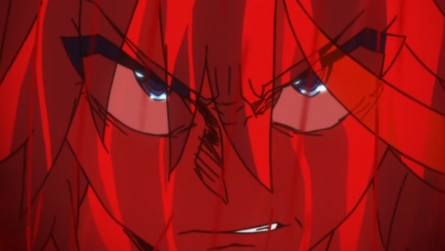
I was planning to write about this series soon, but hey, since it’s become a popular manga, why not now? I’ve been enjoying the craziness that is Kill la Kill and the last few episodes have completely gotten my attention. The main character, Ryuko Matoi, goes through several changes during the whole series. Her brief downfall into madness got me thinking about how overwhelming emotions can be.
This post contains spoilers from late developments in Kill la Kill.
The story of Kill la Kill starts off simple enough. You have the young and rambunctious Ryuko Matoi going after the conservative and composed, Satsuki Kiryurin, who was responsible for the death of her father. As the story progresses, it goes from one of revenge to one of preservation. The world is threatened by alien beings that are the foundations of clothing called Life Fibers. Ragyo Kiryurin, Satsuki’s mother, is the mastermind behind their constant growth. She decides to warp Ryuko as part of her conquest, as it turns that she has Life Fibers inside her. Ryuko becomes one of the bad guys for a brief period until Satsuki and a host of other characters managed to knock some sense into her.
When talking about Ryuko’s descent into madness, Ragyo had this to say about her emotional state when she manipulated her into wearing Kamui Junketsu, an outfit made out of Life Fibers that is treated as battle armor.
“When the life of its host is in danger, it (Junketsu) causes the Life Fibers to become even more active. No matter how hard Soichiro (father of Ryuko) tried to seal them away, it’d be child’s play to reawaken her by making her experience intense existential terror.”
Throughout the series, Ryuko goes through many highs and lows during her journey. She constantly learns and grows, but she reaches arguably the lowest point in Episodes 19-21 when learning of her true origins. The fact that she is a creation made with the same DNA of the enemies she was fighting against causes great shock to Ryuko. Unable to process her thoughts, Ryuko yells at those who supported her and proclaims that she is a cursed monster.
Emotional shock and trauma can happen at any time and is often unpredictable. No matter how prepared you may be, the normal reaction to something out of the ordinary is one of the heart. It is much tougher for children to handle shock as they aren’t as mentally-equipped as adults to handle certain types of feelings. While Ryuko is a strong character in her own right, she is still a teenager trying to figure herself out after the loss of her father.
Experiencing constant losses can add to the shock. The more you suffer setbacks and not get anything out of it, the more stressed you become. You see Ryuko lose a bunch. She’s lost battles not only against Satsuki, but to other characters like Uzu Sanageyama, Nui Harime, and the aforementioned Ragyo. Ryuko learned from her failures after every loss, but there comes a point where the effort starts to get tiring. Perhaps a big problem is the number of new experiences one can take.
While growth experts say that getting new experiences and learning new things is important, do they ever mention how that may kill the personal development of a talented individual? An expert never becomes an expert by focusing on many new experiences. Learning is one thing, but taking the time to understand how that knowledge works is another. Ryuko’s life has been nothing but on-the-job training as she has to handle many revelations. There was a point where she was frustrated at her former homeroom teacher and fellow comrade-in-arms, Aikuro Mikisugi, for hiding the truth of her existence and blamed him for her unstable state of mind.
The lack of significant adult presence in Ryuko’s life didn’t help either. Her parents went AWOL on her when she was little. The only exception was the Mankanshoku family, who showed her what the idea of family was like for a short while. Teens should have fun with their peers, but deep down, they want a sense of guidance and safety that only adults can provide. Teens tend to act invincible to hide their inner fears. Adults have the ability to show them how to properly react and behave when it comes to emotional trauma.
There are many kids out there today that have gone through emotional pain. Some may not get over it, even as they get older. What Kill la Kill seems to highlight is that killing trauma can be a never-ending cycle. It’s funny because the series, in my opinion, seems to be about killing the troubles that are killing you. Once your fresh “kill” becomes too much to bear, you kill that and repeat once that becomes a bother. Think about it – we have to build a huge “body count” of past feelings/troubles to keep ourselves going.
Kill la Kill sure has the makings of an interesting after-school special, doesn’t it?
(c) Manga Therapy – Where Psychology & Manga Meet – Read entire story here.